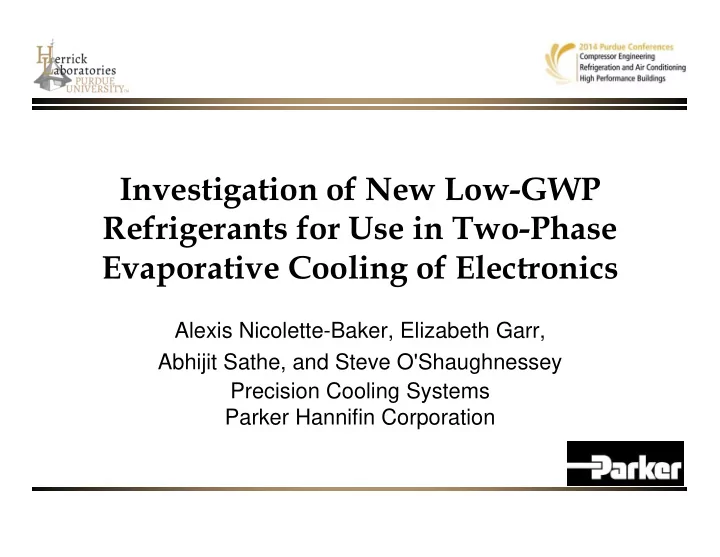

Investigation of New Low-GWP Refrigerants for Use in Two-Phase Evaporative Cooling of Electronics Alexis Nicolette-Baker, Elizabeth Garr, Abhijit Sathe, and Steve O'Shaughnessey Precision Cooling Systems Parker Hannifin Corporation
Background Global warming from refrigerants a major environmental concern Kyoto Protocol AHRI Low-GWP Alternative Refrigerants Evaluation Program identifies several candidates for replacement of R134a Four fluids – R1234ze, R1234yf, N-13a and N-13b are among 12 candidates identified by AHRI for R134a replacement Parker Precision Cooling Systems www.parker.com/pc 2
Candidate Fluid Overview Name R134a R1234ze R1234yf N-13a N-13b Type Pure fluid Pure fluid Pure fluid Blend Blend R134a: 42 Composition R134a: 42 R1234ze: 40 (% Mass) R1234ze: 58 R1234yf: 18 Enthalpy of 182.28 170.50 149.29 168.71 173.51 Vaporization GWP 1430 6 4 604 604 (100 Years) Parker Precision Cooling Systems www.parker.com/pc 3
Vapor Pressure vs. Temperature 4.5 4 R134a R1234yf 3.5 R1234ze N ‐ 13a 3 N ‐ 13b Pressure (MPa) 2.5 2 1.5 1 0.5 0 150 200 250 300 350 400 Temperature (K) Parker Precision Cooling Systems www.parker.com/pc 4
Saturated Pressure vs. Enthalpy 10000 Pressure (kPa) 1000 R134a R1234yf R1234ze N ‐ 13a N ‐ 13b 100 150 200 250 300 350 400 450 Enthalpy (kJ/kg) Parker Precision Cooling Systems www.parker.com/pc 5
Parker 2-Phase Cooling System Microchannel Heat Sink Inverter Drive Cooling Unit Condenser Accumulator Pump Parker Precision Cooling Systems www.parker.com/pc 6
Parker 2-Phase Cooling System 5000 70°C Pressure [kPa] 2000 50°C 1 2 3 1000 30°C 0.2 0.4 0.6 0.8 500 50 100 150 200 250 300 Enthalpy [kJ/kg] P-h diagram with R134a System schematic Parker Precision Cooling Systems www.parker.com/pc 7
Testing Goals Determine what system changes need made for alternative refrigerants » Refrigerant line sizes – Tubing – Hosing – Inter connects » Refrigerant flow rates – Pump – Condenser – Heat sink Parker Precision Cooling Systems www.parker.com/pc 8
Experimental Setup T – Thermocouple (9) P – Pressure sensor (6) Parker Precision Cooling Systems www.parker.com/pc 9
Test Procedure Heat load to heat sink was controlled by adjusting input voltage to electric heaters Refrigerant subcool of 2 °C was maintained by adjusting condenser fan speed Refrigerant exit quality was calculated by energy balance on heat sink Exit quality was varied by changing the liquid pump speed which in turn varied refrigerant volume flow rate Parker Precision Cooling Systems www.parker.com/pc 10
� Test Matrix Heat load Q 500 550 600 650 700 750 800 850 900 950 1000 (W) Refrigerant exit quality X 30 40 50 60 70 80 (%) Refrigerant mass flow rate � 5.5 7 8.5 (g/s) Uncertainties for pressure, temperature and volume flow rate are ± 1 %, ± 1 °C and ± 3 %, respectively. Parker Precision Cooling Systems www.parker.com/pc 11
Data Reduction Refrigerant quality � �� � � �� � � � � �� Q � ��� � � �� � � � � � �� Heat transfer coefficient � � ���� � � ���� ,���� ∙ ∆� �� �� � ∆� 2 � ∆� 1 ∆� �� �∆� 2 1 � ∆� Parker Precision Cooling Systems www.parker.com/pc 12
Refrigerant Flow Rate vs. Heat Load 35 70% exit quality 30 25 Volume flow rate [LPH] 20 R134a 15 R1234ze R1234yf 10 N ‐ 13a N ‐ 13b 5 0 400 500 600 700 800 900 1000 1100 Heat load (W) Parker Precision Cooling Systems www.parker.com/pc 13
Refrigerant Flow Rate vs. Exit Quality 40 500 W heat load 35 R134a R1234ze 30 R1234yf N ‐ 13a Volume flow rate [LPH] N ‐ 13b 25 20 15 10 5 0 0.2 0.3 0.4 0.5 0.6 0.7 0.8 0.9 Exit quality Parker Precision Cooling Systems www.parker.com/pc 14
Refrigerant Flow Rate Comparison 40 % change in required R1234ze R1234yf N ‐ 13a N ‐ 13b volume flow rate of 35 candidate fluids % Increase in volume flow rate over R134a compared with R134a 30 R1234yf required ~ 34% 25 more flow than R134a N-13b required ~ 8% 20 more flow than R134a 15 10 5 0 0.3 0.4 0.5 0.6 0.7 0.8 Exit quality Parker Precision Cooling Systems www.parker.com/pc 15
Pump Pressure Rise vs. Exit Quality 25 Mass flow rate = 0.007 kg/s 20 Pump pressure rise [kPa] 15 10 R134a R1234ze R1234yf N ‐ 13a 5 N ‐ 13b 0 0.2 0.3 0.4 0.5 0.6 0.7 0.8 0.9 Exit quality Parker Precision Cooling Systems www.parker.com/pc 16
Heat Transfer Coefficient vs. Exit Quality 23 Average heat transfer coefficient at mass flow Average heat transfer coefficient [kW/m 2 ‐ K] rate of 0.007 kg/s 22 21 R134a R1234ze 20 R1234yf N ‐ 13a N ‐ 13b 19 0.2 0.3 0.4 0.5 0.6 0.7 0.8 0.9 Exit quality Parker Precision Cooling Systems www.parker.com/pc 17
Average Heat Transfer Coefficient Comparison Exit quality % change in average 0.3 0.4 0.5 0.6 0.7 0.8 0 heat transfer coefficients of candidate fluids % change in heat transfer coefficiens compared to R134a ‐ 1 compared with R134a ‐ 2 ‐ 3 ‐ 4 ‐ 5 ‐ 6 ‐ 7 ‐ 8 R1234ze R1234yf N ‐ 13a N ‐ 13b ‐ 9 ‐ 10 Parker Precision Cooling Systems www.parker.com/pc 18
Conclusions R1234ze, R1234yf, N-13a, N-13b were experimentally tested for possible replacement of R134a in Parker’s two phase liquid cooling system R134a performed the best in terms of volume flow rate, pressure drop and heat transfer coefficient All candidate fluids exhibited significant drop in system performance No clear alternative to replace R134a » Selection of alternate fluid depends on design criteria Parker Precision Cooling Systems www.parker.com/pc 19
Conclusions Important system design parameters and suitable refrigerant(s) Criteria Importance Candidate R1234yf and GWP Environment R1234ze Volumetric Flow Rate Pump Sizing N-13b Pump Power Pressure Drop R1234yf Consumption Heat Transfer Heat Sink Thermal R1234yf Coefficient Resistance Parker Precision Cooling Systems www.parker.com/pc 20
Acknowledgements We thank Honeywell, Inc. for supplying the fluids for testing. Questions Parker Precision Cooling Systems www.parker.com/pc 21
Recommend
More recommend